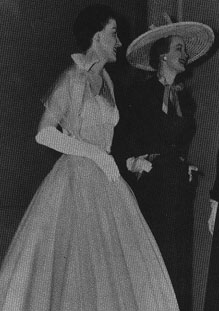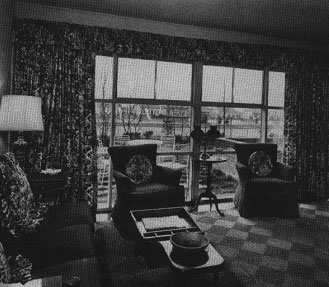The Social Implications of Television
(or, How We Became a Bunch of Couch Potatoes)
Television's rapid adoption rate has led to a decline in family interaction. It stems from both, the TV's seduction of the child to the parent's use of it as an escape-hatch for child-rearing. The family ritual of sharing the day's experiences during dinner has been replaced by vapid television watching, and minimal interactions between family members.
For instance, a young woman in Chicago reminisces about her childhood and says:
| "And then all of a sudden I remember becoming suddenly aware of how different everything had become. The kids were no longer playing Monopoly or Clue or the other games we used to play together. It was because we had a television set which had been turned on for a football game. All of that socializing that had gone on previously had ended. Now everyone was sitting in front of the television set, on a holiday, at a family party!"(4) |
A number of research studies back this woman's claim. One survey found that 78 percent of respondents indicated no conversation taking place during viewing except at specified times such as households. Thirty-six percent of the respondents in another study indicated that the television was the only family activity they participated in during a week!(5) Television has clearly led to a decline in communication and interaction in the family.
How did families allow television to become such a large part of their lives? Television played on a parent's need for an easy pacifier for their children. In fact, numerous studies have shown that the television became an "electronic baby-sitter" for moms (both working and stay-at-home(6).) As families became more child-centered, children became more dependent and demanding of their parents. Of course, the child also developed physical, emotional, and intellectual strengths not found in the children of the previous generation but there was also an increased need of parental attentiveness. Child rearing became more submissive and children became more time consuming. Parents started to have a harder time managing their more demanding children and their more demanding work lives. Beating, starvation, and even mild shaming were now frowned upon. With the arrival of the television, parents had a way of completely pacifying their child with a flip of a switch. Better yet, they seemed to like it too!
Some parents even tried their hardest to hook their kids. They rationalized this coaxing by forcing children to just watch educational television shows like Sesame Street and Mr. Rogers. In another example a Denver mother of two preschool girls interrupted her girls play and told them "It's time for Sesame Street" since she thought it "was a good thing to offer.(7)" Soon she discovered that her children were watching less educational shows like Underdog or the Flintstones. She lost control and her kids wanted nothing more than to watch television, often screaming if they were interrupted. The child was raised into the ultimate passive consumer.
With television becoming the fundamental source of leisure for children, a noticeable decline in active child play has been noticed. Studies have shown that passive play experiences inevitably make active play less appealing and therefore less likely to occur spontaneously(8). Children today are also so used to immediate gratification via the television set that their abilities to amuse themselves have atrophied. Their lack of original free time experience also leaves them with undeveloped abilities, such as originality and improvisation.
Mind you, families still do special things together at times: go to a ball game, go to the zoo or vacation. These are all special events though. Ordinary family life has transformed into one where everyone has their regular schedule of television programs and bedtime, often with parents even having a "peaceful" dinner together without their children(9).
Some studies show that even though family interactions have become limited to television viewing, since these viewings have become more frequent, we see family's being brought to together to watch television. This is especially true in the 50s and 60s when households only owned one television. However, bringing parents and children together did not necessarily make families get closer. Family interactions lost their uniqueness, and became generic. This was mostly spearheaded by the television's dramatic power to sway and shape public opinion.
A dramatic example of television's influence on the American public is the famous Nixon-Kennedy televised presidential debate. In a stunning example of how important looks and presentation are, nearly all spectators who "saw" the event on television claimed Kennedy won, whereas all the spectators who "heard" the event on the radio gave the victory to Nixon. Ultimately, Kennedy won the presidential election. In a symbolic way, television scored a victory over radio.
|
However, the Kennedy’s weren't the first to profoundly shape American culture. Nearly ten years earlier, Mamie Eisenhower influenced the fashion of America's female population. As the most visible proponent of the "New Look", a highly feminine look created by Christian Dior and exported to America from France, she drew mobs of people who always wondered where the "Mamie Look" would go next. As a rampant supporter of consumerism, she once told reporters at a state affair in Paris that she got her hat "by mail order from home. It cost me $9.95!(10)"
From New York to Dallas to Chicago, a "national" female fashion look started sweeping the country. What was originally a style sequestered to the New York high society can now be found everywhere in America. Gone were the local unique styles of different parts of America. All women started to dress alike. Television, with the help of the first lady, brought about a singular fashion revolution in America. In the process, it homogenized the American female look.
|

Mamie Eisenhower (r.) showing off the new look. (As Seen On TV, page 20)
|

An example of Grandma Moses’ Representative Art (As Seen On TV, page 75)
|
The living room, as the home of the television, was naturally influenced by the invention. One of the most dramatic examples of this was the "Paint-by-Number" phenomenon. Generic "representative art" boomed, as people needed to get the perfect picture to match their sodas. Even though there was a large abstract art movement in the US, the most popular pictures were simple realistic images of idyllic landscapes. Basically, calendar art was what sold in America(11) .
Representative art drew its strength from television's intrusion into the 1950s living room. The new paint-by-numbers kits depicted scenes ripped straight from the popular television shows of the era. Just as television could transport people to distant places, representative art was doing the same. Unfortunately, this "art" consisted of nothing more than applying certain colors to certain spaces according to directions. Just as television spurred passive child play, it now spurred passive adult hobbies.
|
|
Another extreme case of how television dictated how things should look was the entire suburban-rustic style. This style was direct result of Disney's Davy Crockett series, which was a tremendous success in the mid 1950s. All in all, television dictated how to decorate your living room and other living spaces.
Ultimately, the television movement has lead to the definitive passive consumer. In the process it has turned our children into inactive television watchers, and stifled communication amongst family matters. The speculative design I plan on introducing will try to combat these social trends, and it will try to this using the television itself.
|

A Davy Crockett inspired living room (As Seen on TV p 125)
|
nv27@cornell.edu

